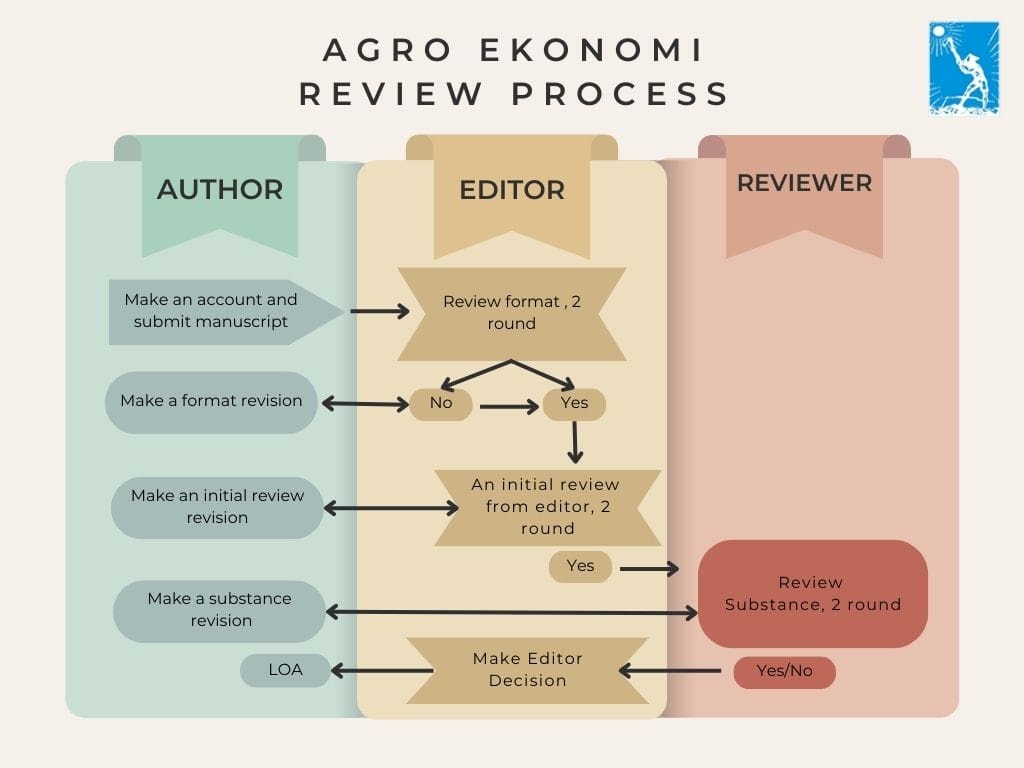GDP, Trade Tax, and Economic Distance's Influence on Ghana's Cocoa Trade with Trading Partners
John Atsu Agbolosoo(1*), Fanny Septya(2), Tanti Novianti(3)
(1) Department of Agricultural Economics, Faculty of Economics and Management, Institut Pertanian Bogor (IPB) University and Agricultural Manager at Afarinick Company Ltd and Researcher at Council for Scientific and Industrial Research-Plant Genetics Resources Research Institute (PGRRI), Ghana
(2) Department of Agribusiness, Faculty of Agriculture, Universitas Riau, Kampus Bina Widy
(3) Department of Agricultural Economics, Faculty of Economics and Management, Institut Pertanian Bogor (IPB) University
(*) Corresponding Author
Abstract
Keywords
Full Text:
PDFReferences
Abafita, J., & Tadesse, T. (2021). Determinants of global coffee trade: Does RTAs matter? Gravity model analysis. Cogent Economics and Finance, 9(1), 1892925. https://doi.org/10.1080/23322039.2021.1892925
Abasimi, I., & Salim, A. (2022). A Gravity Model Analysis of the Influencing Factors of Ghana-Nigeria Bilateral Trade in Merchandize Products. Jurnal Ekonomi Dan Pembangunan, 12(1), 41–52. https://doi.org/10.12928/optimum.v12i1.5571
Adelina, S., Purnomo Wibowo, R., & Hasyim, H. (2020). Analysis of the Export Determinants of Indonesian Cocoa with Gravity Model Approach. International Journal of Research and Review (Ijrrjournal.Com), 7(10), 10.
Agbolosoo, J. A., Midamba, D. C., Massaquoi, I., & Sari, R. M. (2024). Influential Factors of Indonesian Cocoa Export: Evidence from FMOLS and DOLS Approaches. International Journal of Agricultural Economics, 9(6), 295–305. https://doi.org/10.11648/j.ijae.20240906.12
Aragie, E., Balié, J., Morales, C., & Pauw, K. (2023). Synergies and trade-offs between agricultural export promotion and food security: Evidence from African economies. World Development, 172. https://doi.org/10.1016/j.worlddev.2023.106368
Azmi, S. N., Khan, K. H., & Koch, H. (2024). Assessing the effect of INSTC on India’s trade with Eurasia: an application of gravity model. Cogent Economics and Finance, 12(1). https://doi.org/10.1080/23322039.2024.2313899
Bekele, W. T., & Mersha, F. G. (2019a). A Dynamic Panel Gravity Model Application on the Determinant Factors of Ethiopia’s Coffee Export Performance. Annals of Data Science, 6(4), 787–806. https://doi.org/10.1007/s40745-019-00198-4
Bekele, W. T., & Mersha, F. G. (2019b). A Dynamic Panel Gravity Model Application on the Determinant Factors of Ethiopia’s Coffee Export Performance. Annals of Data Science, 6(4), 787–806. https://doi.org/10.1007/s40745-019-00198-4
Benlaria, H. (2024). The Impact of Economic Factors on Saudi Arabia’s Foreign Trade with BRICS Countries: A Gravity Model Approach. Economies, 12(11). https://doi.org/10.3390/economies12110305
Bonuedi, I. (2013). Determinants of Ghana’s Bilateral Trade Flows: A Gravity Model Approach. Kwame Nkrumah University of Science and Technology.
Bonuedi, I., Kamasa, K., Evans, E., & Opoku, O. (2020). Enabling trade across borders and food security in Africa. Food Security, 12, 1121–1140. https://doi.org/10.1007/s12571-020-01095-y/Published
Eshetu, F. (2024). Determinants of Ethiopian sesame and coffee exports to its major trade partners: application of the gravity model. Cogent Social Sciences, 10(1). https://doi.org/10.1080/23311886.2024.2334114
Ghana Cocoa Board. (2023a). Cocoa traceability system: A model for decent farmer income.
Ghana Cocoa Board. (2023b). Cocobod-Turnaround-Strategy.
Ghana Statistical Service. (2025). Ghana 2024 Trade Report.
Kastner, T., Chaudhary, A., Gingrich, S., Marques, A., Persson, U. M., Bidoglio, G., Le Provost, G., & Schwarzmüller, F. (2021). Global agricultural trade and land system sustainability: Implications for ecosystem carbon storage, biodiversity, and human nutrition. In One Earth (Vol. 4, Issue 10, pp. 1425–1443). Cell Press. https://doi.org/10.1016/j.oneear.2021.09.006
Khayat, S. H. (2019). A gravity model analysis for trade between the GCC and developed countries. Cogent Economics and Finance, 7(1), 1703440. https://doi.org/10.1080/23322039.2019.1703440
Khmeleva, G. A., Kurnikova, M. V., Kandrashina, E. A., & Guseva, M. S. (2025). The Assessment of the Potential of Russian Grain Trade in Asian and African Countries: A Gravity Model Approach. Sustainability (Switzerland), 17(2). https://doi.org/10.3390/su17020413
Nisa, D. P. J. I. N., Darsono, & Antriyandarti, E. (2023a). Determinants of Cocoa Bean Trade in the International Market: Gravity Model Approach. International Journal of Sustainable Development and Planning, 18(10), 3347–3356. https://doi.org/10.18280/ijsdp.181035
Nisa, D. P. J. I. N., Darsono, & Antriyandarti, E. (2023b). Determinants of Cocoa Bean Trade in the International Market: Gravity Model Approach. International Journal of Sustainable Development and Planning, 18(10), 3347–3356. https://doi.org/10.18280/ijsdp.181035
Putri, D., Ivo, J., Nisa, N., & Antriyandarti, E. (2023). The Determinant of Indonesian Cocoa Export Growth to the Main Export Destination Countries. Jurnal Ilmiah Teknik Elektro Komputer Dan Informatika (JITEKI), 9(4), 1035–1044. https://doi.org/10.26555/jiteki.v9i4.27232
Ravi Kumar, K. N., Reddy, K. G., Shafiwu, A. B., & Mohan Reddy, M. J. (2024). Trade determinants and opportunities for Indian rice: a dynamic panel gravity model perspective. Cogent Economics and Finance, 12(1). https://doi.org/10.1080/23322039.2024.2312367
Thai-Ha, L. (2017). Does economic distance affect the flows of trade and foreign direct investment? Evidence from Vietnam. Cogent Economics and Finance, 5(1), 1403108. https://doi.org/10.1080/23322039.2017.1403108
Tsowou, K., & Gayi, S. K. (2019). Trade Reforms and Integration of Cocoa Farmers into World Markets: Evidence from African and non-African Countries. Journal of African Trade, 6(1–2), 16. https://doi.org/10.2991/jat.k.190916.001
United States Department of Agriculture Foreign Agriculture Service. (2025). Ghana- Cocoa Sector Overview- 2025.
Verter, N. (2016). Cocoa export performance in the world’s largest producer. Bulgarian Journal of Agricultural Science, 22(5), 713–721.
Wahab, B. A. (2023). Drivers of Manufacturing Export Performance in Nigeria: An Application of the GMM Estimation Approach. Saudi Journal of Economics and Finance, 7(11), 548–560. https://doi.org/10.36348/sjef.2023.v07i11.010
Wijaya, I. (2020). Indonesia cocoa bean in international trade. International Journal of Business, Economics & Management, 3(1), 226–233. https://doi.org/10.31295/ijbem.v3n1.250
Yeboah, E., Jing, Y., & Lucy, A. (2020). Overview of Ghana’s Export and Import, FDI inflow and outflow: Is there any connection between its trading partners and the source of its foreign investing countries? Asian Journal of Interdisciplinary Research, 64–77. https://doi.org/10.34256/ajir20236
Yeboah, O.-A., Shaik, S., Morrill Hall, D., Wozniak, S., Moore, C., Allen, A. J., Lloyd-Ricks, G., & Wing, W. (2003). Give to AgEcon Search Increased Cocoa Bean Exports under Trade Liberalization: A Gravity Model Approach. 1–17. http://ageconsearch.umn.edu
Article Metrics
Refbacks
- There are currently no refbacks.
Copyright (c) 2023 Agro Ekonomi

This work is licensed under a Creative Commons Attribution-ShareAlike 4.0 International License.
View My Stats












